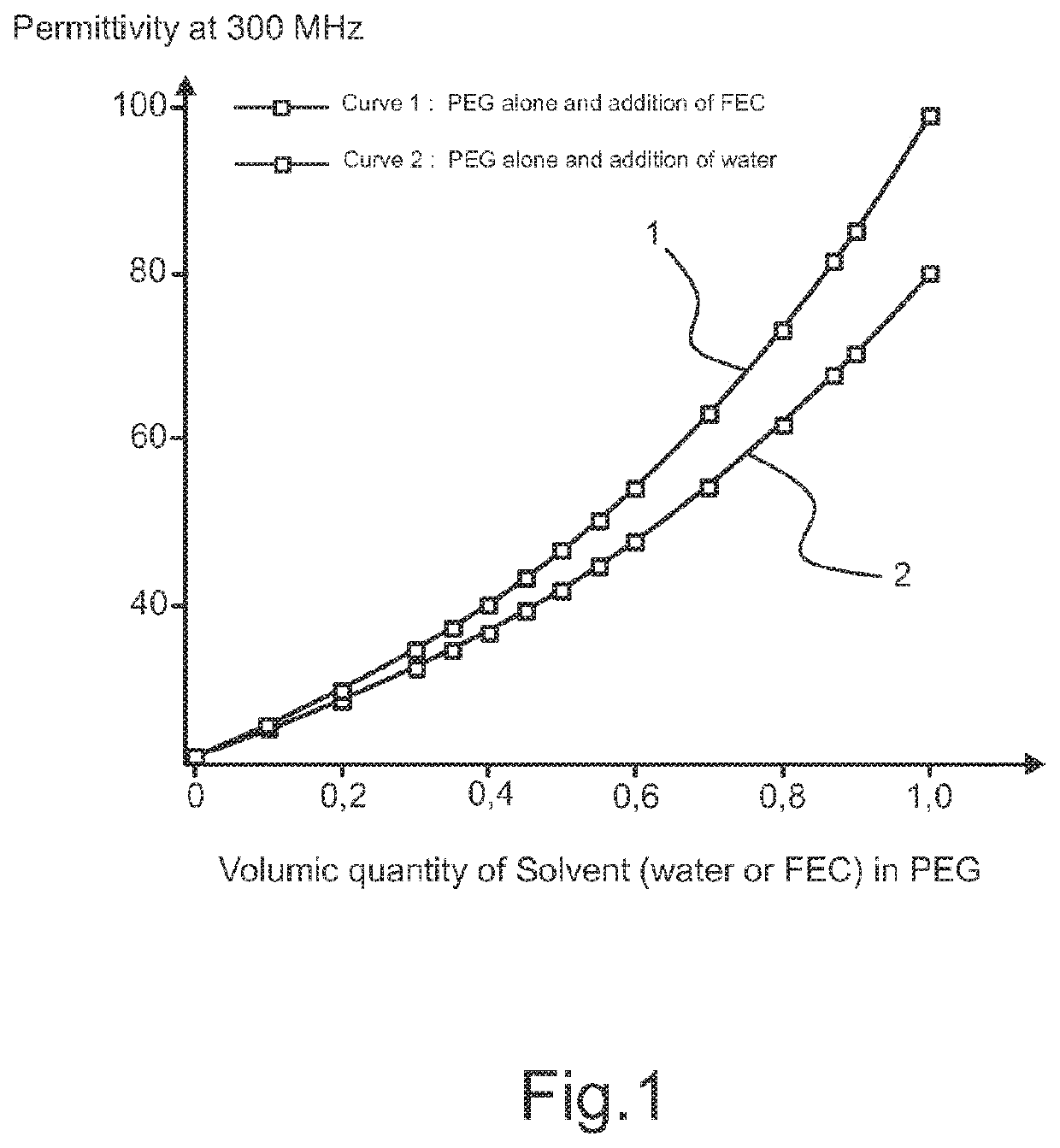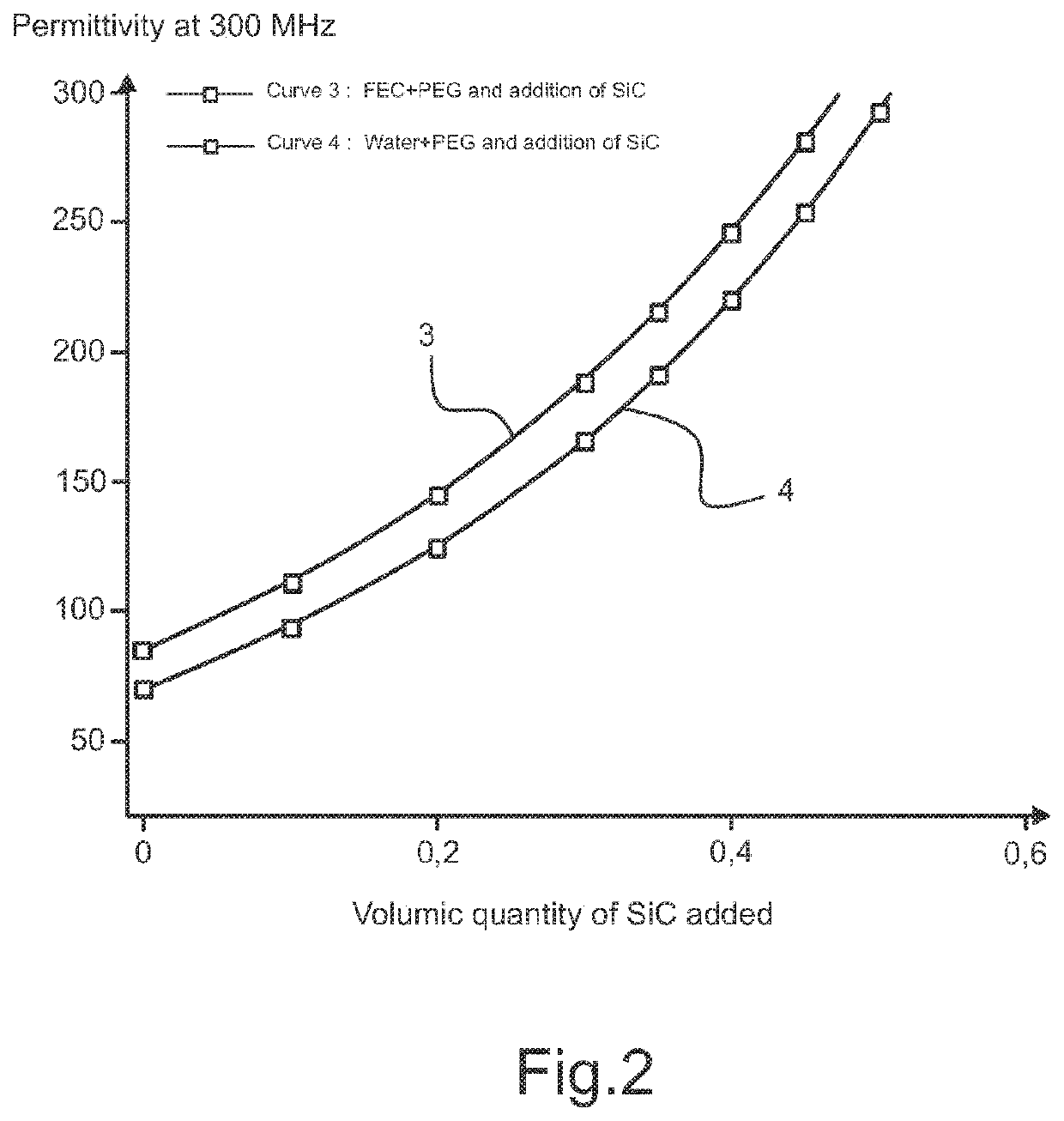Materials with high dielectric constant for magnetic resonance imaging instruments
a magnetic resonance imaging and dielectric constant technology, applied in the direction of instruments, magnetic measurement, magnetic variable regulation, etc., can solve the problems of not clearly defining the permittivity, no longer homogeneous water-charge composition, and blank signal areas
- Summary
- Abstract
- Description
- Claims
- Application Information
AI Technical Summary
Benefits of technology
Problems solved by technology
Method used
Image
Examples
example 1
Simulation of Permittivity at 300 MHz Related to the Volume Solvent Amount in Polyethylene Glycol (PEG)
[0057]Polyethylene glycol (PEG) has been mixed with fluoroethylene carbonate (FEC) to demonstrate the permittivity evolution of this mixture compared to the permittivity evolution of the mixture containing polyethylene glycol and water (see FIG. 1).
[0058]As it is shown in FIG. 1, the permittivity of the mixtures increases with the volumetric amount of solvent. Moreover, the mixture with FEC displays better permittivity than the mixture containing water thus allowing to add more dispersant at a given permittivity level.
example 2
Simulation of Permittivity at 300 MHz Related to the Volumetric Amount of Filler
[0059]As it is shown. in FIG. 2, a mixture of EEC, PEG and SiC demonstrated better permittivity at 300 MHz, compared to the mixture of water, PEG and SiC.
[0060]This association of solvent having a melting point between 14° C. and 50° C., a dispersant and a dielectric charge aims in particular to prevent the sedimentation of particles, to easily control the viscosity of the matrix, to limit the risks of heterogeneity, and to limit the evaporation of the solvent, in order to obtain a pad as efficient as those based on barium titanate but more comfortable, with a longer lifespan and lower toxicity.
example 3
Required Quantities to Prepare 100 g of the Composite Material
[0061]The table 3 below features the quantities in g of the solvent (fluoroethylene carbonate—FEC) and dispersant (Polyethylene glycol—PEG) to be mixed for producing 100 g of solvent with dispersant:
TABLE 3% in volumeWeights (g)FEC10 to 99.513 to 99.6PEG0.5 to 90 0.4 to 87
[0062]The table 4 below features the quantities in g of silicon carbide powder to be mixed with the solvent with dispersant for the production of 100g of composite:
TABLE 4% in volumeWeights (g)Solvent with10 to 95.5 4.5 to 87.7dispersantSiC4.5 to 90 12.3 to 95.5
[0063]The table 5 below features the quantities in g of silicon carbide powder, fludroethylene carbonate and Polyethylene glycol to mix for the realization of 169 g of composite in the ideal case:
TABLE 5% in volumeWeights (g)Solvent with5051.4dispersant (90vol. % EEC + 10vol. % PEG)SiC50117.6
[0064]The use of this matrix FEC+PEG with respect to the water makes it possible to have a real permittivi...
PUM
 Login to View More
Login to View More Abstract
Description
Claims
Application Information
 Login to View More
Login to View More - R&D
- Intellectual Property
- Life Sciences
- Materials
- Tech Scout
- Unparalleled Data Quality
- Higher Quality Content
- 60% Fewer Hallucinations
Browse by: Latest US Patents, China's latest patents, Technical Efficacy Thesaurus, Application Domain, Technology Topic, Popular Technical Reports.
© 2025 PatSnap. All rights reserved.Legal|Privacy policy|Modern Slavery Act Transparency Statement|Sitemap|About US| Contact US: help@patsnap.com


